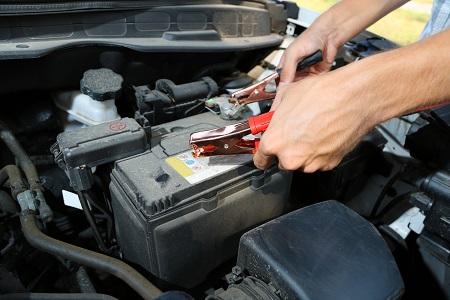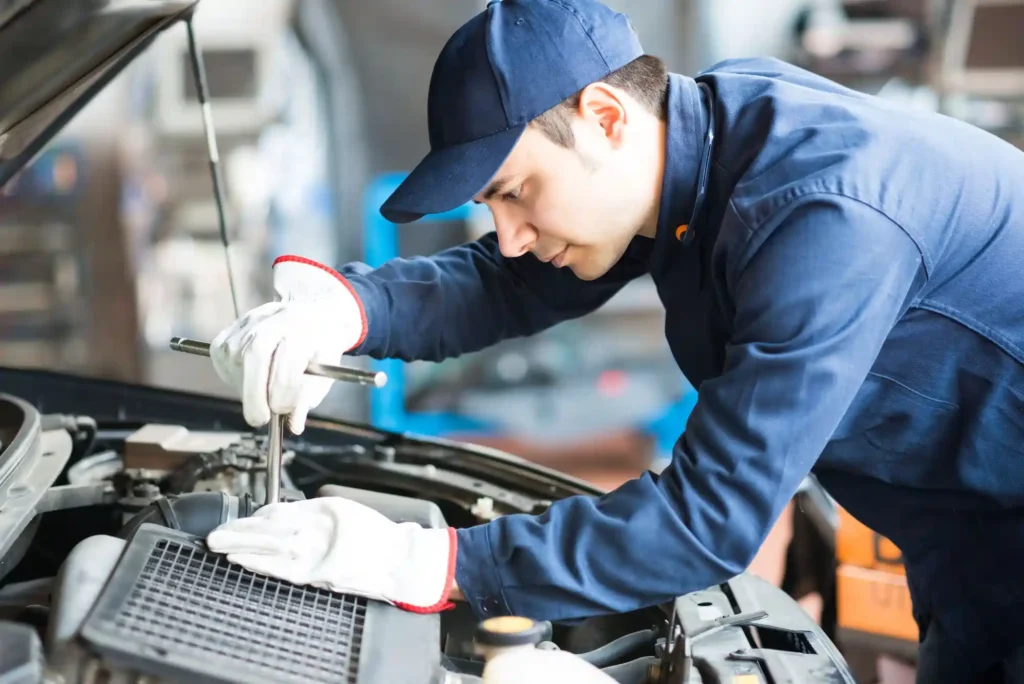Truck Won’t Start but Battery and Starter Are Good?
It’s frustrating when you turn the key, and your truck won’t start, even though the battery and starter motor are working fine.
You might expect the engine to roar to life, but instead, nothing happens—or maybe you hear clicking or cranking, but the engine refuses to run.
If your battery has power and your starter is functioning, other truck parts might be causing the problem.
Issues with fuel delivery, ignition, fuses, or sensors can prevent your truck from starting, even if the electrical system seems fine.
In this guide, we’ll walk you through step-by-step troubleshooting to find out why your truck won’t start.
By checking different components one by one, you can figure out what’s wrong and get back on the road.
Understanding the Starting System
Before diagnosing the issue, it’s important to understand how a truck starts. Several systems work together to get the engine running.
If even one of them fails, the truck won’t start, even if the battery and starter motor are fine.
1. Battery Voltage & Power Flow
A truck’s electrical system depends on a strong battery voltage. Even if the battery terminals are connected, the battery might not be delivering enough power. Here’s what to check:
- The battery should have at least 12.6V when fully charged.
- Corroded battery terminals can block power flow. Cleaning them ensures a strong connection.
- A weak grounding wire can prevent the truck from starting.
2. Starter Motor & Solenoid
The starter motor and starter solenoid work together to crank the engine. The solenoid gets power when you turn the key, activating the starter motor to spin the engine.
If the solenoid or motor is faulty, the truck won’t crank. Signs of a problem include:
- A clicking sound but no cranking.
- No sound at all, which could mean the starter solenoid isn’t receiving power.
- Loose or blown fuses in the starter circuit.
3. Ignition System
The ignition system sends signals to start the engine. If any part of this system fails, the truck won’t start. Key components include:
- The ignition switch, which sends power to the starter solenoid.
- The ECU (Engine Control Unit), which manages ignition timing.
- Fuses and relays, which allow power to flow through the system.
4. Fuel & Air Delivery
Even if the electrical system is working, the engine needs fuel and air to start. Common issues include:
- A faulty fuel pump, preventing fuel from reaching the engine.
- Clogged fuel injectors, blocking fuel flow.
- A blocked air intake system, preventing oxygen from mixing with fuel for combustion.
A problem in any of these areas could be why your truck won’t start but the battery and starter are good. In the next section, we’ll go step by step to diagnose and fix the issue.
Common Causes and Troubleshooting Steps

Even if your battery and starter motor are working fine, other issues can still prevent your truck from starting. Below, we’ll go through possible causes and how to troubleshoot them step by step.
A. Electrical System Issues
1. Blown Fuse or Bad Relay
- A blown fuse in the starter circuit can cut power to the starter solenoid or ignition switch.
- A bad relay, like the starter relay or ignition relay, can prevent power from reaching the starter motor.
- How to Check: Open the fuse box, look for burned-out fuses, and replace them if necessary. You can also swap the starter relay with a similar one to test it.
2. Corroded or Loose Battery Terminals
- Corrosion on battery terminals can block power flow, making the truck seem like it has no power.
- Loose or dirty grounding wires can also cause weak electrical connections.
- How to Fix:
- Disconnect the battery terminals and clean them with a wire brush and baking soda solution.
- Tighten all connections and check the grounding wire for damage.
3. Bad Ignition Switch
- The ignition switch sends power to the starter solenoid and other systems. If it’s faulty, the truck won’t crank.
- Symptoms:
- No response when turning the key.
- Accessories (radio, lights) don’t turn on.
- How to Test:
- Use a multimeter to check for voltage at the ignition switch.
- Try bypassing the switch with a jumper wire to see if the truck cranks.
4. Faulty Engine Control Unit (ECU)
- The ECU controls many starting functions. If it malfunctions, the truck may not get the correct signals to start.
- If your truck has electrical malfunctions, such as daytime running lights (DRL) staying on even when the truck is off, it could indicate deeper ECU or wiring issues that might also affect starting.
- Symptoms:
- Check engine light is on.
- No power to the starter despite a good ignition switch.
- How to Check: Use an OBD-II scanner to read ECU error codes. If there’s a fault, a mechanic may need to reprogram or replace the ECU.
B. Fuel Delivery Problems
1. Bad Fuel Pump or Clogged Fuel Filter
- If the fuel pump isn’t working, fuel won’t reach the engine even if the electrical system is fine.
- A clogged fuel filter can block fuel flow.
- How to Test:
- Turn the key to the “ON” position and listen for a fuel pump humming sound. If there’s no sound, the pump may be bad.
- Use a fuel pressure gauge to check fuel pressure. Low pressure means a bad fuel pump or clogged filter.
2. Faulty Fuel Injectors
- Fuel injectors spray fuel into the engine. If they’re clogged, the truck won’t start.
- Symptoms:
- Engine cranks but won’t fire.
- Rough idling or misfires when trying to start.
- How to Fix:
- Use a fuel injector cleaner to clear minor blockages.
- If injectors are badly clogged, they may need to be replaced.
C. Air Intake & Combustion Issues
1. Blocked Air Intake System
- If the air intake system is clogged, the engine won’t get enough air to start.
- How to Check:
- Inspect the air filter—if it’s dirty, replace it.
- Open the throttle body and clean any carbon buildup.
2. Failing Spark Plugs (Gas Engines)
- Bad spark plugs or ignition coils won’t ignite the fuel-air mixture, preventing the engine from starting.
- Symptoms:
- Truck cranks but doesn’t start.
- Engine misfires.
- How to Fix:
- Remove and inspect the spark plugs for wear.
- Replace bad plugs and check the ignition coils for proper function.
3. Compression Issues
- If the engine has low compression, it won’t start. This could be due to worn-out piston rings or damaged valves.
- How to Test:
- A mechanic can perform a compression test to check for low pressure.
- If compression is too low, internal engine repairs may be needed.
D. Safety & Security System Malfunctions
1. Neutral Safety Switch (For Automatic Transmissions)
- The neutral safety switch prevents the truck from starting unless it’s in Park or Neutral.
- Certain AWD and 4WD systems rely on electronic controls to engage properly.
- If your truck isn’t recognizing the correct gear or mode, it might not start or move as expected.
- How to Check:
- Shift the truck into Neutral and try starting it.
- If it starts, the neutral safety switch may be faulty and need replacement.
2. Anti-Theft System Preventing Start
- Some trucks have an anti-theft system that can disable the ignition.
- Symptoms:
- Security light flashing on the dashboard.
- Engine cranks but doesn’t fire.
- How to Fix:
- Try using a backup key.
- If the system is stuck, reset it by locking/unlocking the truck with the key fob.
3. Push-Start Key Fob Issues (For Modern Trucks)
- If your truck uses a push-button start, a dead key fob battery can prevent it from starting.
- How to Fix:
- Try using a spare key fob.
- Hold the key fob near the push-start button and press it—many trucks have an emergency start feature.
By following these troubleshooting steps, you can figure out why your truck won’t start but the battery and starter are good. In the next section, we’ll go over quick fixes and when to call a mechanic.
How to Diagnose the Issue Quickly

If your truck won’t start but the battery and starter are good, you can quickly narrow down the problem by following these simple steps:
1. Check Dashboard Warning Lights
- Turn the key to the ON position and look at the dashboard lights.
- Pay attention to these warning lights:
- Check Engine Light – Could indicate a problem with the ECU, fuel system, or sensors.
- Security Light – If flashing, the anti-theft system may be preventing the truck from starting.
- Battery Light – Even with a good battery, a bad alternator could cause starting issues.
2. Listen for the Fuel Pump Sound
- When you turn the key to ON (without starting), listen for a quiet humming sound from the fuel pump.
- If you don’t hear it, the fuel pump could be faulty or the fuel pump relay might have failed.
3. Use an OBD-II Scanner
- Plug in an OBD-II scanner and check for error codes.
- Common codes that could indicate a starting issue:
- P0230-P0233 – Fuel pump relay or circuit issues.
- P1682 – Ignition switch fault.
- P0335-P0339 – Crankshaft position sensor failure.
- These codes can help pinpoint whether the issue is electrical, fuel-related, or sensor failure.
4. Try Jump-Starting the Truck
- Even if the battery seems fine, a voltage drop can still cause starting problems.
- Jump-starting the truck can help rule out a weak battery or poor battery terminal connections.
5. Test Relays and Fuses
- Locate the starter relay, fuel pump relay, and related fuses in the fuse box.
- Swap them with known working relays of the same type.
- If the truck starts, the problem was a bad relay or blown fuse.
6. Attempt a Push Start (Manual Trucks)
If you drive a manual truck, attempting a push start can sometimes help bypass electrical issues and get the engine running.
However, if you’re stuck on snow, ice, or mud, even a push start might not be enough.
In such cases, having a traction aid like the TruckClaws™ II Light Truck Kit can provide the necessary grip to get moving again, especially if your wheels are slipping instead of catching traction.
Steps to Push Start:
- If your truck has a manual transmission, try a push start:
- Put the truck in 2nd gear.
- Hold the clutch down and get someone to push the truck.
- Once rolling, release the clutch while turning the key to start.
- If it starts, the issue may be with the starter relay, ignition switch, or a weak battery.
By following these steps, you can quickly diagnose the reason why your truck isn’t starting and decide if you can fix it yourself or need a mechanic.
Preventative Maintenance Tips
To avoid future issues where your truck won’t start despite a good battery and starter, follow these simple maintenance steps:
1. Regularly Clean Battery Terminals & Grounding Wires
- Corrosion on battery terminals can cause poor connections, leading to intermittent starting problems.
- Clean the terminals with a wire brush and apply anti-corrosion spray.
- Check grounding wires to ensure a solid connection to the chassis.
2. Check & Replace Fuel Filters Periodically
- A clogged fuel filter can reduce fuel flow, making the truck harder to start.
- Most manufacturers recommend replacing the fuel filter every 20,000–40,000 miles.
- Replacing can also improve the fuel efficiency of your truck.
3. Inspect Spark Plugs & Ignition Coils
- Worn-out spark plugs or faulty ignition coils can cause misfires, rough idling, and difficulty starting.
- Replace spark plugs every 30,000–50,000 miles (or as recommended by the manufacturer).
4. Keep an OBD-II Scanner for Quick Diagnostics
- A portable OBD-II scanner can quickly check for trouble codes before issues become serious.
- It helps diagnose problems with the ignition system, fuel pump, or sensors.
5. Watch for Early Warning Signs
- Slow cranking – Could indicate a weak battery, bad alternator, or poor grounding.
- Dimming lights – Electrical issues may affect the starting system.
- Rough idling or stalling – Might signal fuel delivery problems or ignition failure.
Regular maintenance helps prevent unexpected breakdowns, but even a well-maintained truck can face traction challenges in tough conditions.
For those driving heavy-duty commercial trucks, keeping a reliable traction aid like the TruckClaws™ Commercial Super Single Kit in your emergency gear ensures you’re ready for any situation where your truck needs extra grip to stay moving.
By following these maintenance tips, you can prevent sudden starting issues and keep your truck running smoothly.
When to Call a Mechanic

Sometimes, even after going through all the troubleshooting steps, your truck still won’t start. In such cases, it might be time to seek professional help. Here’s when you should call a mechanic:
1. If DIY Troubleshooting Fails
- You’ve checked the battery, starter, ignition system, fuel pump, relays, and sensors, but the truck still won’t start.
- No clear error codes show up on the OBD-II scanner.
- You’ve tested multiple fixes, but nothing seems to work.
2. Serious ECU or Electrical Issues
- A failing Engine Control Unit (ECU) can cause miscommunication between components, preventing the truck from starting.
- Complex wiring problems, like a short circuit, blown fuses, or a bad relay, require specialized tools to diagnose.
- Issues with the anti-theft system that prevent the truck from starting.
3. Internal Engine Damage
- Compression loss due to worn piston rings, head gasket failure, or valve issues.
- Timing chain or belt failure can throw off engine timing, stopping the truck from starting.
- Signs like strange noises, backfiring, or excessive smoke may indicate serious engine problems.
4. DIY vs. Professional Repair – Cost Comparison
| Problem | DIY Cost | Mechanic Cost |
|---|---|---|
| Battery Terminal Cleaning | $5 (Wire Brush) | $50–$100 |
| Replacing Spark Plugs | $20–$100 | $150–$300 |
| Changing Fuel Filter | $20–$80 | $100–$250 |
| Ignition Coil Replacement | $50–$300 | $200–$500 |
| Fuel Pump Replacement | $100–$400 | $500–$1,500 |
| ECU Repair/Replacement | $200–$800 | $500–$2,000 |
If the repair is simple (like cleaning terminals or replacing spark plugs), DIY is cost-effective. However, complex issues like ECU failure, compression problems, or engine damage should be handled by a mechanic to avoid bigger repairs later.
Conclusion
When your truck won’t start but the battery and starter are good, the problem likely lies in other critical components like the ignition system, fuel delivery, air intake, or electrical connections.
The most common causes include:
- Blown fuses or bad relays disrupting the power flow.
- A faulty ignition switch preventing the starter from engaging.
- A bad fuel pump or clogged fuel filter stopping fuel from reaching the engine.
- Blocked air intake or bad spark plugs preventing combustion.
- Security system malfunctions disabling the ignition.
Rather than guessing, it’s important to follow a step-by-step troubleshooting approach—checking for warning lights, listening for fuel pump noise, scanning for error codes, and testing relays to pinpoint the issue.
To prevent future problems, keep up with commercial vehicle maintenance like cleaning battery terminals, replacing fuel filters, checking spark plugs, and using an OBD-II scanner for early detection of faults.
If DIY troubleshooting doesn’t solve the problem, or if you suspect serious electrical or engine damage, consult a professional mechanic for proper diagnostics and repair.
